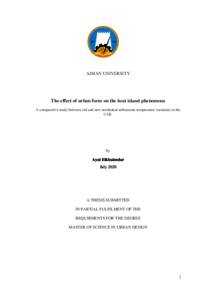وثيقة
download count
2.00
The relation between the urban morphology and the urban heat island effect
العنوان البديل
A detailed study of SKH. Mohammad Bin Rashid housing establishment housing developments in Dubai, UAE.
الناشر
Ajman University
تاريخ النشر (نص حر)
2021
اللغة
الأنجليزية
مدى
110 leaves
الموضوع
الملخص
Abstract:
Human activities on earth cause several harmful effects on the environmental level, therefore it affects all creatures living on it. The urban heat island phenomenon is considered as one of the well-known effects results by these activities. This phenomenon has been studied and examined extensively especially within the past decade. However, this research explore the relation between the urban morphology of newly developed housing projects within an arid desert climate and the urban heat island effect and how air temperature, relative humidity, and wind pattern will change accordingly. Four newly developed housing projects of SKH.
Mohammad Bin Rashed Housing Establishment in Dubai, UAE, was chosen to conduct this study.
The urban configuration of Site 1 (Al Barsha South), Site 3 (Oud Al Muteena), Site 6 (Al Warqah 4), and Site 8 (Al Khawaneej) were studied were simulated using computer software Envi-met in two seasons (Summer & Winter). Also, a digital thermometer was used to take on-site measurements for software validation and ensuring the accuracy of results.
Study findings show that housing developments with low buildings density have recorded low air temperature values as in site 6 (Al Warqah 4) which represent the lowest building density (5.08 U/H) among the other studied sites. On another hand, site 8 (Al Khawaneej) which has the highest building density (9.09 U/H) has recorded the lowest relative humidity values due to the heat release caused by concrete masses which will reduce humidity values by creating a steam of convection wind near the ground level. Finally, the study shows that streets-oriented NE-SW and NW-SE tend to show a higher wind speed compared to streets oriented to other directions which will reduce the relative humidity values as well.
المجموعة
مواد أخرى لنفس الموضوع


